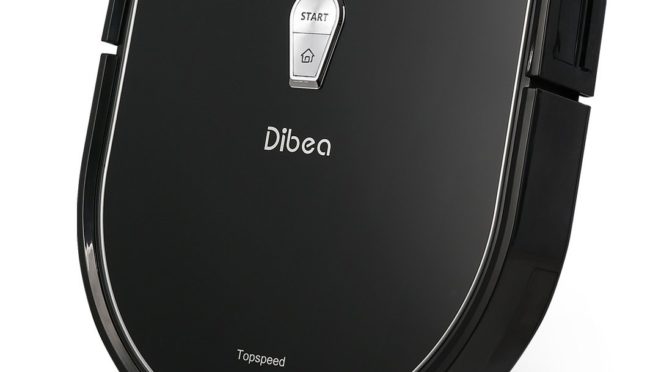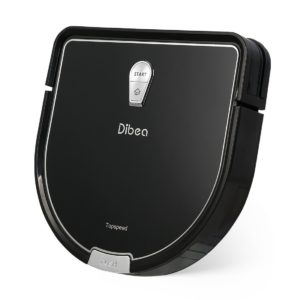
These days, it seems like everyone and their mother has come out with a robotic vacuum cleaner. If you’ve got $300, Roomba will sell you the 690, 652, or 650. Shark will sell you the RV750 and RV720. And a dozen other companies you’ve probably never heard of (e.g., Ecovacs) will sell you things like the Deebot N79.
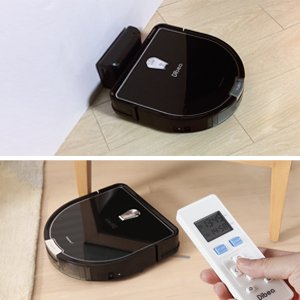
But with so many little machines claiming to clean your home for the price of a ticket to Vegas, it can be hard to figure out what’s actually going to leave your carpets clean and what’s just going to zoom off your stairs and empty your wallet. Today we’re going to take a look at the Dibea D960 Robot Vacuum and compare it to another little-known (but highly rated) vacuum, the D79, to see which is better for your money. Our short review is that while the D960 does a good job cleaning, we trust the D79 more to hold up past the warranty period. You can buy the Dibea D960 here or buy the Deebot D79 here.
Pros, Cons, and Key Features of the Dibea D960 Robotic Vacuum
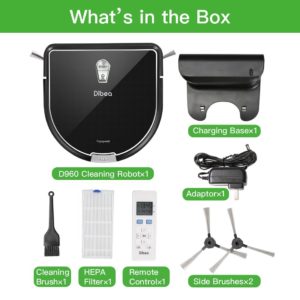
The Dibea D960 is marketed as a competitor to a range of robotic vacuums currently flooding the market, and on paper at least, includes some pretty tempting features. It’s battery-powered, programmable, and includes a remote control. It is not Wi-Fi or smart phone compatible. Perhaps its biggest claim to fame is a 2 hour (120 minute) runtime from its Li-on battery pack. The battery takes around 3 hours to charge. The D960 has a 350 ml-sized dust bin, up to 1,200pa of suction, and a 12 inch cleaning radius. It weighs 6.6 pounds on our scale and also includes H11-grade HEPA filtration. Rather than the traditional O or round shape for robotic vacuums, the Dibea uses the D-shape popularized by Neato (e.g., in the Botvac Connected). Dibea also describes the D960 as very quiet due to its motor design.
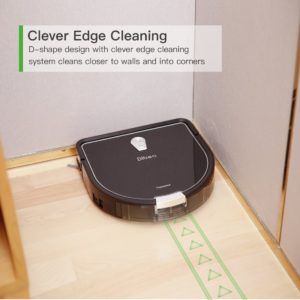
Inside the box, you’ll find the D960 itself with its battery pre-installed and partially charged, a charging base and adapter, a remote, and extra side and cleaning brushes as well as a HEPA filter. You’ll also find a user’s guide and the same too-short one year manufacturing warranty that every robotic vacuum cleaner appears to have copied nearly word for word from every other on the market. Yes, this is a pet peeve of ours, although we can’t blame Dibea for sticking to the same low standards everyone else is right now.
How well does the Dibea D960 actually clean carpets and hardwood floors?
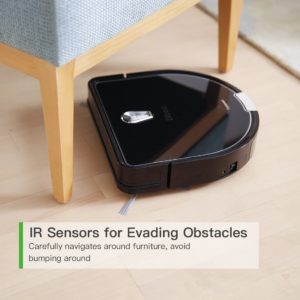
While the D960 has a number of impressive features on paper–most notably the battery life–nothing matters if it doesn’t actually deliver in practice. The verdict is mixed. Let’s look at the good news first.
When it came to navigation, we were pleased with the level of intelligence programmed into the D960. While it definitely wasn’t the smartest robotic vacuum we’ve come across (that award would go to the Roomba 980 and 960), when it came to finding its way across a room, it did so without repeating itself more than the typical machine we’ve reviewed in its price range. True to Dibea’s word, when done cleaning or when low on battery, the D960 would return faithfully to its charging base to recharge or pat itself for a job well done.
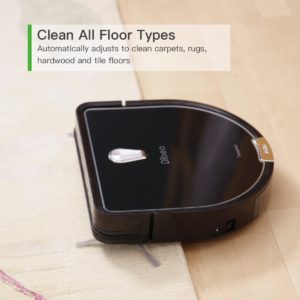
In terms of cleaning, it was comfortable on hardwood floors and low-pile carpets and rugs. Despite Dibea’s warnings not to try it on medium- or high-pile carpets we had to see for ourselves, and confirmed Dibea’s honest assessment of its limits; the D960, like every robotic vacuum we’ve tested besides the Botvac Connected, was no match for higher pile carpets. Our standard recommendation of buying a canister like the Miele Compact C2 Electro+, the Miele Classic C1 Titan, or the Miele Classic C1 Delphi continues to apply; any of the above combined with the D960 will still cost less than a high-end do-everything vacuum like the Miele Complete C3 Cat & Dog.
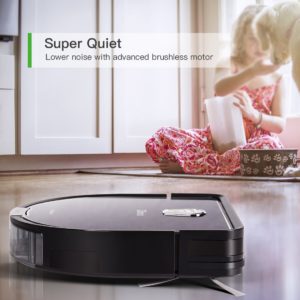
That’s the good news. The bad news is that some of Dibea’s claims were more on the spectrum of optimistic, if not fake news. First of all, despite their assurance that it would be a very quiet machine, we didn’t find it any quieter than any other robotic vacuum. This wasn’t that much of a strike against it; we just noted it because we read a number of dubious reviews claiming the vacuum was as quiet as a feather falling a mile away. Practically speaking, it was pretty average.
The bigger breach of reality was the claim of a 120 minute battery life. In practice, we struggled to see more than 60 minutes when using it in a mixture of carpet and bare flooring. Maybe we had a bad battery, but it left us with skepticism, especially paired with reports we’ve heard of the battery losing capacity sooner than expected. It’s certainly possible that you might get 120 minutes when using a new battery on glass-like floors, but we wouldn’t hold out hope for 120 minutes of real-world use; you’ll need to invest in something like the Roomba 980 for that (which does back up its 120 minute claim in real life).
What’s the difference between the Dibea D960 and the Deebot N79?
Practically speaking, the main difference between the D960 and the N79 is that the N79 is a.) Wi-Fi and smart phone compatible and b.) has a longer (100 minutes vs 60 minutes) practical battery life. Given the much wider distribution of the N79 (and much greater opportunities for flaws to be uncovered as a result) than the D960, we also have more faith in the N79 continuing to work past its warranty expiration than the D960. There are minor differences to note as well, such as the round shape of the Deebot vs the D-shape of the Dibea or the wider cleaning path of the Deebot compared to that of the Dibea, but the biggest differences are the ones we’ve already noted.
Why Buy the Dibea D960?
In conclusion, the D960 is perhaps a cautionary tale about the perils of trying to save too much money–whether for the people who buy it in hopes of saving money over a more established vacuum like the Roomba 690 or for the people who designed it and obtained stellar results in the lab that didn’t quite translate into daily use. It’s not a bad vacuum by any means; we’re just not sure it’s worth buying over a number of other vacuums from manufacturers with longer, more painfully won reputations. There appear to be plenty of happy people with the D960, and it’s possible time will prove it to be an excellent vacuum. However, if you’re more risk adverse, we’d recommend the Deebot N79 or Roomba 690 instead if looking for a sub-$300 robotic vacuum that’ll almost certainly keep working long after your one year warranty is up.
![]() You can buy the Dibea D960 here on Amazon. Alternatively, you can buy the Deebot N79 here or buy the Roomba 690 instead.
You can buy the Dibea D960 here on Amazon. Alternatively, you can buy the Deebot N79 here or buy the Roomba 690 instead.
![]() Canadians can buy the Dibea D960 here, buy the Deebot N79 here, or buy the Roomba 690 here.
Canadians can buy the Dibea D960 here, buy the Deebot N79 here, or buy the Roomba 690 here.
 If you find our research on PMC helpful, you can follow our efforts to keep maniacally reviewing home cleaning tools by shopping through our links above. We promise to keep fighting the good fight against every horror children, animals, and grown, yet messy humans can inflict upon a clean home.
If you find our research on PMC helpful, you can follow our efforts to keep maniacally reviewing home cleaning tools by shopping through our links above. We promise to keep fighting the good fight against every horror children, animals, and grown, yet messy humans can inflict upon a clean home.

